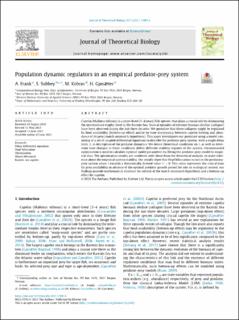| dc.contributor.author | Frank, Anna-Simone Josefine | |
| dc.contributor.author | Subbey, S. | |
| dc.contributor.author | Kobras, Melanie | |
| dc.contributor.author | Gjøsæter, H. | |
| dc.date.accessioned | 2021-09-15T08:49:51Z | |
| dc.date.available | 2021-09-15T08:49:51Z | |
| dc.date.created | 2021-07-20T08:03:47Z | |
| dc.date.issued | 2021 | |
| dc.identifier.issn | 0022-5193 | |
| dc.identifier.uri | https://hdl.handle.net/11250/2777349 | |
| dc.description.abstract | Capelin (Mallotus villosus) is a short-lived (1–4 years) fish species, that plays a crucial role by dominating the intermediate trophic level in the Barents Sea. Several episodes of extreme biomass decline (collapse) have been observed during the last three decades. We postulate that these collapses might be regulated by food availability (bottom-up effect) and/or by time discrepancy between capelin feeding and abundance of its prey (match-mismatch hypothesis). This paper investigates our postulate using a model consisting of a set of coupled differential equations to describe the predator-prey system, with a single delay term, T , in description of the predator dynamics. We derive theoretical conditions on T, as well as determine how changes in these conditions define different stability regimes of the system. Unconstrained optimization is used to calculate optimal model parameters by fitting the predator-prey model to empirical data. The optimization results are combined with those from the theoretical analysis, to make inference about the empirical system stability. Our results show that Hopf bifurcation occurs in the predatory-prey system when T exceeds a theoretically derived value T* > 0. This value represents the critical time for prey availability in advance of the optimal predator growth period.Set into an ecological context, our findings provide mathematical evidence for validity of the match-mismatch hypothesis and a bottom-up effect for capelin. | en_US |
| dc.language.iso | eng | en_US |
| dc.publisher | Elsevier | en_US |
| dc.rights | Navngivelse 4.0 Internasjonal | * |
| dc.rights.uri | http://creativecommons.org/licenses/by/4.0/deed.no | * |
| dc.title | Population dynamic regulators in an empirical predator-prey system | en_US |
| dc.type | Journal article | en_US |
| dc.type | Peer reviewed | en_US |
| dc.description.version | publishedVersion | en_US |
| dc.rights.holder | Copyright 2021 the authors | en_US |
| dc.source.articlenumber | 110814 | en_US |
| cristin.ispublished | true | |
| cristin.fulltext | original | |
| cristin.qualitycode | 1 | |
| dc.identifier.doi | 10.1016/j.jtbi.2021.110814 | |
| dc.identifier.cristin | 1922150 | |
| dc.source.journal | Journal of Theoretical Biology | en_US |
| dc.identifier.citation | Journal of Theoretical Biology. 2021, 527, 110814. | en_US |
| dc.source.volume | 527 | en_US |

